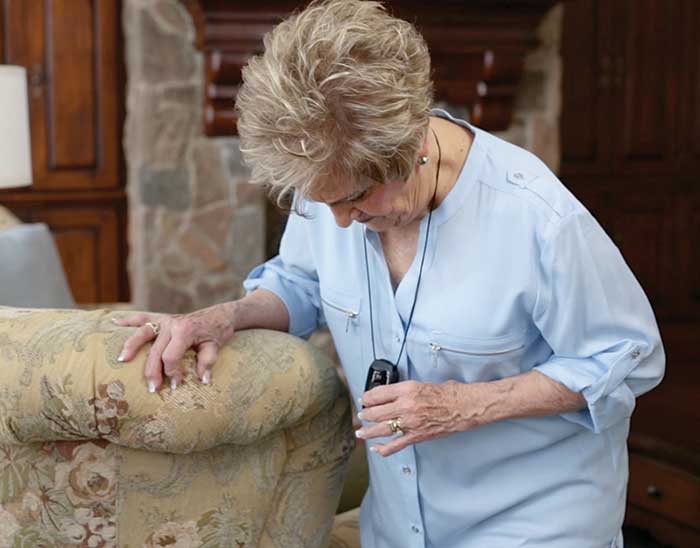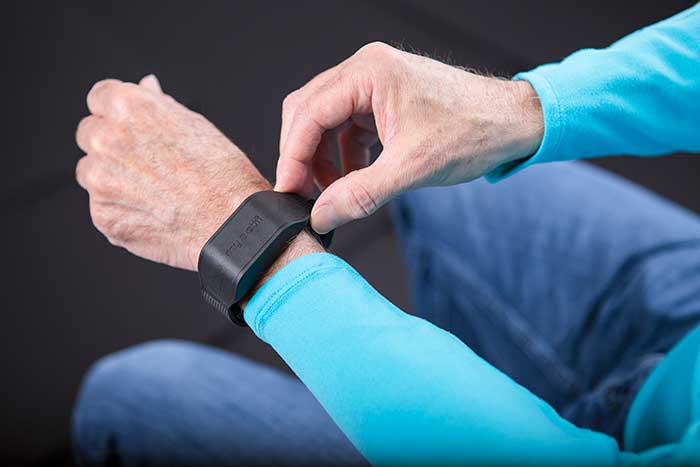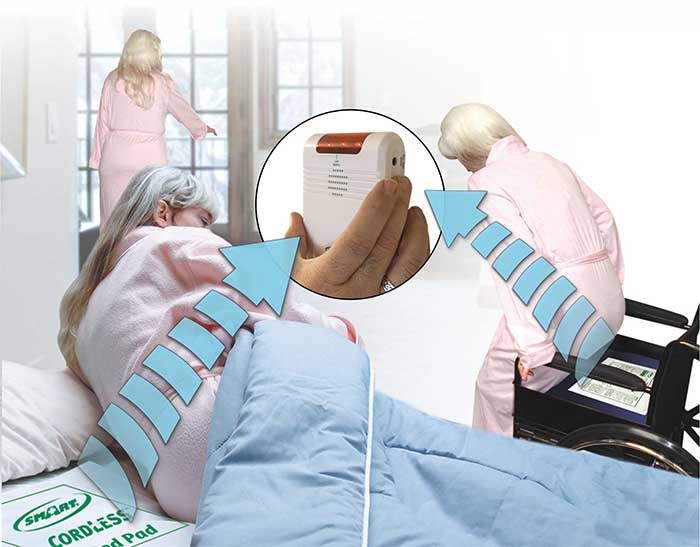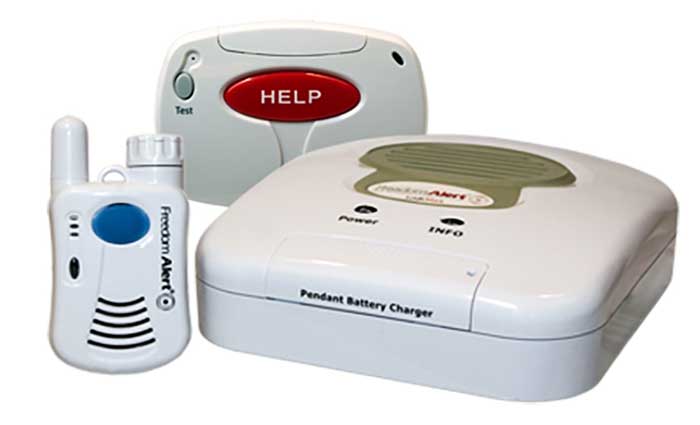FREEUS
Brock Winzeler, COO freeus.com
 Belle+
Belle+Who is best served by your product? WINZELER: Our two-way voice mobile medical alerts most often serve seniors, people with chronic illnesses and individuals at risk for falls. Our mobile PERS devices (mPERS) are also used by lone workers, people at risk for injury on the job, and individuals who exercise alone. How has the market for these products changed during the last three years? WINZELER: We have seen a dramatic shift away from landline PERS to mobile PERS. Installation and maintenance are simple for the dealer, and freedom and flexibility is maximized for the user. How do you differentiate your products from others in the category? WINZELER: Our devices use cellular service to enable users to easily get help wherever they may be. Our products also include proprietary WiFi location technology, which uses nearby WiFi hotspots to locate users in an emergency. Why should PERS products be attractive to HME providers? WINZELER: HME providers can expand their product offering with PERS and become a one-stop shop for their patients’ health and safety product needs. PERS increase recurring revenue for HME businesses and enable providers to maintain a relationship with patients for an extended period. How can HME providers realize profitability with this category? WINZELER: It’s important to set up a specific division within the HME business for PERS, and it’s key to ensure your business hires the right staff for the PERS division and selects and markets PERS products properly. How do you approach product development? WINZELER: We listen to our dealers and their customers, and we focus on creating reliable, easy-to-use mPERS solutions that fit their needs. What tools do you provide to help educate dealers and potential product users? WINZELER: PERS University features educational webinars to help dealers increase sales, along with one-on-one expert guidance. We also have in-house engineering and dealer care teams providing support, and our in-house marketing team provides complimentary customized brochures and videos to dealers.
MEDHAB
Johnny Ross, CEO mynotifi.com Who is best served by your product? ROSS: MedHab’s remote wearable technology serves senior citizens who want to remain independent and engaged in their community, and those at risk of falling. What strategic shifts in business management have occurred? ROSS: Our shift in critical thinking is relative risk to the caregiver managing their senior parents. Their parents want and need independence, and the caregivers want piece of mind. Our technology allows for both. How do you differentiate your products from others in the category?
 MyNotifi wrist wearable
MyNotifi wrist wearableROSS: MyNotifi is a completely remote technology, with the ability to customize range of motion and strengthening exercises that can help the senior prevent falls. Most importantly, the device detects falls, and directly communicates with family caregivers. Why should PERS products be attractive to HME providers? ROSS: The senior population is growing rapidly. Also, caregiving is not only relegated to the family, but to providers. Remote technology can help to foster this arrangement and potentially offer reasonable recurring revenue streams. How can HME providers realize profitability with this category? ROSS: Recurring revenue streams can be realized via the use of remote technology, especially when a professional caregiver can partner directly with the senior and/or with the family of the senior. What are the key considerations patients/caregivers should know about PERS products? ROSS: Caregivers should evaluate the senior’s living arrangements, family support and financial situation in order to make informed decisions regarding products to best fit the need. What tools do you provide to help educate dealers and potential product users? ROSS: We provide online support videos, animated apps, and click-through user manuals capture screenshots to make it as easy as possible to use our devices.
CONNECT AMERICA
Robert Melzi Marketing Manager, Home Healthcare Division connectamerica.com
 Connect America
Connect AmericaWhat is your specialty? MELZI: We specialize in working with homecare organizations in formal and informal arrangements. Our goal is assist the clients of our partners to remain within their community. Our specialty solution varies depending upon the need. What strategic shifts in business management have occurred? MELZI: The ability to drop ship the product to the customer. Today, most of the equipment that is in the field is simple enough to use that the customer can install and activate the equipment on their own. How has the market for PERS products changed during the last three years? MELZI: We saw a great shift from landline-based equipment to cellular and mobile-based equipment. The overall reason for this shift is that people are getting rid of their landline phone lines. Why should PERS products be attractive to HME providers? MELZI: The retention of clients. We always recommend that our partners get consent from their client to be listed as a contact in the case of an emergency. If this occurs, the agency has a greater chance of retaining or reacquiring their client after an incident occurs. If a person is no longer on service and an event occurs, the agency will be notified and can follow up accordingly. What trends have you identified for PERS/mPERS products? MELZI: Like all technology, mPERS and cellular PERS change frequently. Some people prefer having a wearable device with two-way voice built into the device (vs. the traditional method of having a base station). The goal is to find the best and most customer-friendly product. What are the key considerations patients/caregivers should know about PERS products? MELZI: PERS products are not only for those who are homebound or cannot perform activities of daily living on their own. The reason you want to acquire a PERS product is for peace of mind that in the case of an emergency, you will be able to obtain assistance.
SMART CAREGIVER CORPORATION
Mary Lou Rishell National Sales smartcaregiver.com What is your specialty? RISHELL: Fall prevention and anti-wandering products are all we do. What strategic shifts in business management have occurred to help grow the business? RISHELL: The online marketplace has increased product exposure and opportunity to educate and present economical solutions to the HME and the home-based care industries. How has the market for these products changed during the last three years? RISHELL: There are new systems in retail packaging, pre-programmed and ready to use—all the customer needs to do is insert the batteries included in the package.
 Cordless bed pad and alarm
Cordless bed pad and alarmWhat forces have putthe most pressure on this product category? RISHELL: The Medicare and Medicaid CMS regulation released at the end of 2017 has caused confusion in using fall prevention monitors. We have the solution and have been able to confirm that we have products that comply with the regulation, and caregivers should continue to use our fall monitors while caring for their patients, residents or loved ones. How do you differentiate your products? RISHELL: We offer professional grade products at an affordable price and we stand behind them 100 percent. How can HME providers realize profitability with this category? RISHELL: The need for fall prevention and anti-wandering is in high demand and growing. The challenge is to educate the HME providers on the product so they can in turn educate their customers. Once this is done, significant growth can be realized. How do you approach product development? RISHELL: We listen to our distributors on what they feel the market is lacking, as well as what their customers are requesting. What educational tools do you provide? RISHELL: We offer product training via phone or Skype. We also provide product instructions. Dealers and potential product users can call into our customer service team with product questions. We also answer questions via our “Instant Chat” on our website.
LOGICMARK
Kevin O’Connor, President logicmark.com What is your specialty? O’CONNOR: PERS products with two-way voice built into the pendant that calls caregivers or 911, and allows the user to speak/listen directly through the pendant without a monthly fee. What market segment is best served by your product? O’CONNOR: Our product serves seniors living independently. In many cases, their adult children purchase the unit to provide peace of mind. What strategic shifts in business management have occurred to help grow the business? O’CONNOR: We looked at technology shifts and developed products that meet the changing needs of seniors by providing cost-effective solutions in a form factor that is easy and intuitive for seniors to use.
 LogicMark Platform
LogicMark PlatformWhat forces have put the most pressure on this product category? O’CONNOR: The need for PERS solutions for seniors that are more mobile has created the need for more solutions with cellular capability. How are you responding to the demand for value-based medical products/devices? O’CONNOR: In 2018 we will be expanding our strategy to provide products that will monitor vitals for patients that have been discharged from the hospital and need to have data collected through a portal for health care professionals. Why should PERS products be attractive to HME providers? O’CONNOR: There is no need to carry significant inventory, and some of our customers that do PERS consistently will order the unit private-labeled with their brand or logo, so that the users always have their name handy on the pendant. What are the key considerations patients/caregivers should know about PERS products? O’CONNOR: Seniors and caregivers need to determine what their concerns are and how they plan on using a PERS device to make sure they get a system that they are comfortable with, can afford and, most importantly, will use. How do you approach product development? O’CONNOR: We try to leverage our current product platforms, as well as working with technology partners to help us develop products faster and more cost effectively. What tools do you provide to help educate dealers and potential product users? O’CONNOR: We have a full-time customer service team to support end-users with questions in the operation of their systems and answer any questions they have. We also work with dealers and resellers to help develop custom marketing materials that help them promote their business and our products. We also provide training webinars.
ALERT SENTRY
Glenn Maxwell, President alertsentry.com
 Alert Sentry
Alert SentryWhat is your specialty? MAXWELL: Offering PERS devices. We only sell through authorized dealers; we don’t sell direct. [We typically serve] seniors over the age of 60 that live at home alone, and people that are active and want fall detection safety at the push of the button. What strategic shifts in thinking have occurred? MAXWELL: Don’t put a box around who you may think is the standard customer. It may not always be someone who is older. How has the market for these products changed? MAXWELL: Fall detection has improved, and placing cellular-based units in the home because not everyone has a landline. Mobile units have GPS tracking to actively track people. Our programs are uniquely tailored to support our dealers’ needs. We’re the only company that doesn’t compete with their dealers. What trends have you identified for PERS/mPERS products? MAXWELL: Mobile units are becoming more popular. We are probably about 50/50 right now, up from 70/30 a few years ago. More people don’t have home phone lines; so cellular-based home units are also increasing in popularity. What are the key considerations patients/caregivers should know about PERS products? MAXWELL: They are affordable and enhance the ability to remain safely at home. If anything happens, getting help in the first hour greatly increases the chances of coming home.
MOBILEHELP
Rob Flippo, CEO Chris A. Otto, SVP, MobileHelp, Healthcare mobilehelp.com
 Mobile Help
Mobile HelpWhat is your specialty? FLIPPO and OTTO: MobileHelp designs and manufactures a wide range of emergency response services and remote patient monitoring solutions. With technology advancements, we’ve been able to provide a wider array of product solutions and services to reach a broader group of seniors and a broader set of customers in general. What strategic shifts in business management have occurred? FLIPPO and OTTO: We recognized many years ago that the key to innovation in the industry was taking the issue further upstream—that is, preventing emergencies (such as falls) from happening in the first place. How has the market for these products changed? FLIPPO and OTTO: The practice of remote biometric data collection, enabled by Bluetooth in devices such as tablets and smartwatches. We are looking to connect our MobileHelp Smart with data collection capabilities that include vital sign monitoring. How do you differentiate your products from others in the category? FLIPPO and OTTO: MobileHelp has sought to bring combination technologies to the industry to allow its customers to not only manage their safety, but their health as well, recognizing that the two are inextricably connected. The company’s website offers a series of considerations for consumers and caregivers to consider, covering topics from features and benefits to look for in an emergency response system to things to consider prior to traveling. How do you approach product development? FLIPPO and OTTO: If we give people the tools they need to engage fully in their own health care while simultaneously giving health care providers the tools they need to more effectively interact with larger patient populations, we will be able to enact real change in the long-term health of a much broader set of people. What educational tools do you provide? FLIPPO and OTTO: MobileHelp has divisions designed to support all its customers: customer service, tech support and an extremely knowledgeable sales force.
